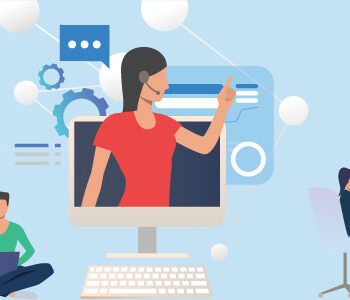
Image Credit: https://www.istockphoto.com/photo/beat-the-deadline-with-technology-gm1094918638-293884804
The digital employee experience refers to the interaction between employees and digital systems and technologies in the workplace. This includes the use of software and digital platforms for communication, collaboration, learning, and job-specific tasks, as well as the overall design and usability of these systems.
The digital employee experience plays an important role in shaping employee satisfaction and engagement and can impact their overall experience at work.
Why does digital employee experience matter to work culture?
Employee experience in the digital age matters to work culture because it greatly impacts an employee’s sense of belonging, job satisfaction, and overall well-being within the organization. The use of technology in the workplace has become an integral part of the modern work environment, and a positive digital experience can facilitate better communication, collaboration, and productivity.
On the other hand, a negative digital experience can lead to feelings of isolation, frustration, and burnout. By prioritizing and improving the digital employee experience, companies can create a more positive and supportive work culture that promotes employee engagement and retention.
What are the key challenges of improving the digital employee experience?
There are several key challenges in improving the digital employee experience, including:
- Technology Adoption: To ensure that employees have access to the technology they need to perform their jobs effectively and that they are trained to use it.
- User Experience: Make sure that digital tools and systems are user-friendly and provide a seamless experience for employees.
- Data Privacy and Security: Ensure that sensitive employee and company information is protected while being stored and shared digitally.
- Integration with Legacy Systems: Integrating new digital tools and systems with existing legacy systems and processes can be a challenge.
- Work-Life Balance: Finding a balance between the convenience and flexibility offered by digital tools and the need for employees to disconnect and maintain a healthy work-life balance.
- Change Management: Managing resistance to change and effectively communicating the benefits of digital initiatives to employees can be a challenge.

Image Credit: https://www.istockphoto.com/photo/human-resource-manager-checks-the-cv-online-to-choose-the-perfect-employee-for-his-gm1352650187-427995846
Potential solutions to create a great digital employee experience
You make things easier and elevate the digital employee experience. There are several ways to attain it efficiently:
- Streamlining HR processes: Implementing self-service portals and automating HR processes like benefits enrollment and time tracking can reduce the workload for HR staff and make it easier for employees to access information and manage their benefits.
- Improving Communication: Providing employees with a platform for collaboration and communication can help improve overall teamwork and productivity.
- Enhancing Workforce Management: Implementing tools that allow employees to manage their schedules, tasks, and workload can help them stay organized and reduce stress.
- Providing access to training and development opportunities: Offering virtual training sessions and courses can help employees develop their skills and improve job satisfaction.
- Encouraging work-life balance: Allowing flexible work arrangements and encouraging regular breaks can help employees maintain a healthy work-life balance.
By implementing these strategies, companies can create a more positive digital employee experience and boost overall employee satisfaction and productivity.







